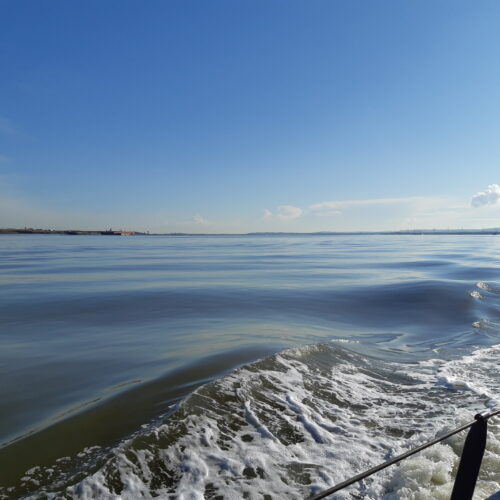The birds are singing, the days are getting longer, spring is here and of course with spring comes spring cleaning. With that in mind this article is all about Sabellidae, the ‘feather duster’ worms.
Sabellids live in long tubes that they construct around their bodies out of mucous. Most species cement particles of mud or sand to their mucous sheath, which grants them protection against predators and rough environmental conditions.
The ‘feather duster’ epithet of this family of polychaetes comes from their characteristic plume of tentacles, called radioles, which are finely divided feather-like structures. The radioles are attached in two groups, one on either side of the worm’s head. In many species, the radioles are brightly coloured, making them fairly sought after for display in aquaria. As well as being pretty, these “feathers” are essential for many different processes.
Sabellids use their radioles to feed, by filtering small particles from the water column [1]. Each radiole has paired side branches, forming a two-edged comb, allowing them to trap particles from the water. Amazingly, Sabellids are able to sort these particles according to their size and composition. Particles that are too large are of no use to the worm, so are rejected and carried away by the water current. Medium sized particles are kept for tube building. The finest organic particles are food for these worms, who use the hair-like cilia that line their radioles to channel the particles down to their mouth, where they are ingested.
Due to their filter feeding strategy, Sabellids can only thrive in areas with moving currents that bring in fresh supplies of suspended particles. However, they do not simply passively wait for food to come to them. To facilitate the process, they create a current in the water to direct particles toward their mouth, a practice called “active suspension” feeding. Waving their “feathers,” creates a current and vortices on the upper surface of their radioles. To make this system even more effective, the surface of their radioles is coated in sticky mucus to trap any particles passing through.
Radioles also help with respiration; as the rest of the animal stays within their tube, the opportunity for oxygen exchange is otherwise limited by the amount of water it can pump through its tube. Additionally, for many species of Sabellid, the radioles are involved in photoreception. Their cerebral eyes are of little use, as their “head” is tucked away in their tube most of the time. Thus, photoreceptors on the radioles up in the water column are key for threat detection. Across the different species in the family, there is huge diversity in the type and level of sophistication of these photoreceptors. Some have very simple photoreceptors, which can only give the worm information on the ambient light conditions. Other species have elaborate compound eyes with hundreds of facets, which are thought to be sophisticated enough to confer image-forming vision [2]. These eyes are used to detect predators and the worm will rapidly retract into the safety of its tube when a threat is detected.
Sabellidae is a diverse family with around 46 genera and over 500 species currently described, with numbers continuing to increase with further exploration of poorly studied areas. They have adapted to survive in an incredibly diverse range of habitats, being present in waters from the Arctic and Antarctic right through to the tropics and from the shoreline down to the deep sea and even in completely freshwater [3].
Sabella pavonina (pictured) is a species of Sabellidae found around all UK coasts from the low shore into the subtidal. These worms grow up to 30cm long and build a tough tube which can protrude from the seabed by up to around 10cm [4]. These tubes provide a hard surface that can be colonised by other organisms, which would otherwise not be able to inhabit soft, muddy areas [5]. Sabella, like a number of other genera, have the impressive ability to regenerate both the head and tail ends of their body when broken in two, even managing to regenerate multiple times should they need to [5].
So, if you find yourself doing a spot of dusting in the next few weeks, spare a thought for these remarkable worms.

References
- Capa, M., Kupriyanova, E., Nogueira, J.M.D.M., Bick, A. and Tovar-Hernández, M.A., 2021. Fanworms: Yesterday, Today and Tomorrow. Diversity, 13(3), p.130.
- Bok, M.J., Capa, M., Nilsson, D.E., 2016. Here, There and Everywhere: The Radiolar Eyes of Fan Worms (Annelida, Sabellidae), Integrative and Comparative Biology, Volume 56, Issue 5, November 2016, Pages 784–795, https://doi.org/10.1093/icb/icw089
- Capa, M. and Murray, A., 2015. A taxonomic guide to the fanworms (Sabellidae, Annelida) of Lizard Island, Great Barrier Reef, Australia, including new species and new records. Zootaxa, 4019(1), pp.98-167.Hayward, P.J. and Ryland, J.S. eds., 1995. Handbook of the marine fauna of North-West Europe. Oxford University Press.
- Hayward, P.J. and Ryland, J.S. eds., 1995. Handbook of the marine fauna of North-West Europe. Oxford University Press.
- Murray, J.M., 2010. Regeneration and reproduction in Sabella pavonina (Savigny): developing a novel method to culture marine ornamental sabellids (Doctoral dissertation, University of Portsmouth).











